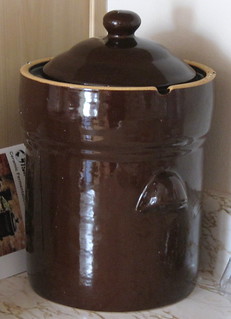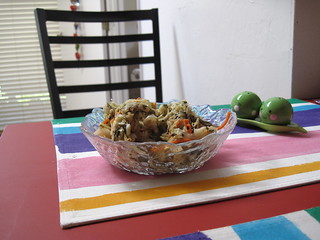If you could change your life by what you ate… you would, wouldn’t you?”
“You Are What You Eat!” was dinned into our wee brains throughout childhood (right along with “If you can’t say something nice, don’t say anything,” but you see how well that went), and we all figured it was true, as far as that went, though most of us imagined our classmates as gigantic chickens or something. (Or, maybe that was only T. Whatever.) But recently the National Institute of Health put out a really surprising report on how what we eat can literally change our mental state. The piece is titled, “Fermented foods, neuroticism, and social anxiety: An interaction model,” and the tl;DR quote you need is:
“A recent study in humans has shown that consumption of a fermented milk product containing a combination of probiotics (Bifidobacterium animalis, Streptococcus thermophiles, Lactobacillus bulgaricus, and Lactococcus lactis) can modulate brain activity (Tillisch et al., 2013). After four weeks of consuming the fermented milk product, there was a reduction in brain activity in a network of areas, including sensory, prefrontal, and limbic regions, while processing negative emotional faces. Importantly, a control group that ingested a non-fermented milk product showed no such changes in brain activity, suggesting that the probiotics in the fermented milk were responsible for the modulation in brain activity. This study demonstrates that fermented foods containing probiotics can alter how the human brain processes negative social stimuli.”
If you’re vegan, you may be shrugging and thinking, “Well, that’s all very nice for the sanity of the omnivores, but…” Nope, think again: probiotics exist in fermented foods of all kinds, even those which have no milk products. An easy one to enjoy? Kimchi. By fermenting vegetables in a salty broth to suppress the whole decay factor of vegetables sitting in water for weeks at a time, lactic acid bacteria takes over the process, creating the magical healthy probiotics that we need.
T’s family had many Korean friends, and growing up, T. ate some really amazing kimchi. T. has a vague memory of her mother attempting to make her own kimchi in a Mason jar… and the Mason jar exploding… so when D. wanted to make kimchi, T. was… not really on board. So, she stalled. This worked for a few weeks until D. found a fermentation crock, and then the whole kimchi thing was on like Donkey Kong, and there was nothing she could do about it. She wasn’t sure what to put in it – some traditional recipes call for shrimp – ugh, imagine that decomposed – and there’s the traditional red pepper powder called gochugaru — kimchi aficionados say it can’t be replaced with just plain cayenne pepper. Nevertheless D. had a new toy, and in went the Baechu (napa) cabbage, red peppers, onions, scallions, garlic, chopped carrots, and crushed roasted seaweed, to add a bit of meaty umami flavoring – the “rocks” to hold down the veg, the water and the salt.
Adding salt to our fermented cabbage this time was …tricky. The first recipe we used added it by weight, and we made the mistake of looking for a “vegetarian-friendly” recipe instead of looking for a KOREAN recipe. Rookie mistake, we are covered in shame. There’s a method to making this properly, and the first is to brine the cabbage – and then rinse it. This is necessary to kill off nasties, but rinsing also helps keep the level of salt down. We had to back up and do this step after we had a delicious but ultimately waaaay tooo salty dish. The second trick is to mix your seasonings into a paste and add it to the cabbage only after it’s all together. That way you can get delicious ginger and garlic and peppery goodness in every bite.
We admit to impatience, and only fermented our cabbgae for three days. It was tasty, but it wasn’t “right,” and we’re going back to the drawing board. Next time we’re looking forward to adding radishes — maybe from our own wee garden! — to the mix, doing the soaking properly, and experimenting with a freer hand with the gochugaru. There are many kinds of kimchi and we have many tasty days ahead of us. Meanwhile, if you’re a fan of sauerkraut, this is a fermented cabbage that kicks it up a notch. (And if you’re not a fan of sauerkraut, rejoice; this is nothing like it, really.)
But, we can sense that some of you remain unconvinced. It’s not enough that the probiotics in fermented foods can increase your mental well-being. You’ve seen real kimchi. It’s red and weird and pungent and even snuggled up next to perfectly steamed rice, you can’t imagine putting such foreignness into your mouth. Uh-huh. Well, consider this:
The 2003 outbreak of SARS in Asia virtually left Korea untouched – possibly because kimchi has been shown to boost immunity. Korean chickens infected with the H5N1 (avian flu) virus recovered after eating food containing the same probiotics found in kimchi. The Journal of Nutrition in 2001 reported that kimchi produces beneficial short chain fatty acids which are reported to inhibit the development of invasive colon cancers. Research reported in 2008 revealed kimchi probiotics fighting ulcer-causing Helicobacter pylori bacteria. The Journal of Medicinal Foods abstract adds, “Health functionality of kimchi, based upon our research and that of other, includes anticancer, antiobesity, anticonstipation, colorectal health promotion, probiotic properties, cholesterol reduction, fibrolytic effect, antioxidative and antiaging properties, brain health promotion, immune promotion, and skin health.”
From various studies, kimchi aids in digestion, lowers total cholesterol, is an antioxident, reduces inflamation in skin breakouts, lowers BMI, beefs up the immune system, reduces oxidative stress in blood cells, inhibits the growth of cancer cells, increases glucose tolerance, especially when eaten with a low fat food; inhibits gastric ulcers, combats nutrient depletion, builds stamina and helps prevent yeast infections. Are we at least a little more on-board with this? Hope so. Tune in ’til the next Feat of Fermentation.
*Yes, yes, we know we’re bizarre. Normal people are talking about their home microbrewing when they discuss fermentation. Haven’t you figured out by now that we’re never Those People? Get with the program, folks; even when we’re swanning around in the sky we don’t do “normal” here.



Yum! And now I’m having miso soup for lunch~inspired by this reading.